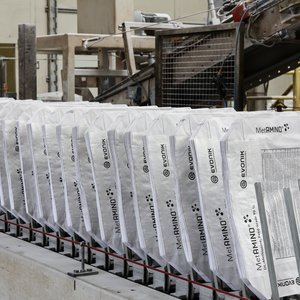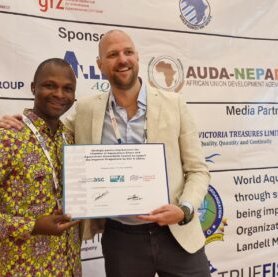Setting the Record Straight on SLICE
An October 21, 2008 column by Walter Cordery in The Nanaimo Daily News, which we included in our lat Aquafeed.com newsletter, contains numerous misleading statements and fallacies with regards to the monitoring and treatment of sea lice at BC salmon farms. According to the BC Salmon Farmers Association Mr. Cordery did not attempt to contact them, nor any of numerous veterinarians who are fish health experts prior to writing his article; therefore, since the article does not provide readers with an accurate and balanced understanding of salmon farming and the sea lice issue. the association has made the following information available:
To read Mr. Cordery’s article click here
To read what Health Canada has to say about emamectin benzoate (Slice) use click here
To read information from the Association of Aquaculture Veterinarians of BC click here
To read the 2007 Ministry of Agriculture and Lands Fish Health Program report click here
For more information on sea lice from the BCSFA click here
To view a video that explains Marine Harvest’s sea lice management program click here
The following are responses to the inaccuracies and misrepresentations presented in Mr. Cordery’s article.
| Walter Cordery writes… | The facts are… |
| “…the lice, which seem to multiply exponentially wherever salmon farms are located.” | This is not correct. Sea lice on farmed salmon are monitored and recorded at each farm site on a monthly basis. The results of this monitoring are shared with and audited by the BC Ministry of Agriculture and Lands to ensure adherence to regulations that are designed to protect both the health of farmed salmon and of wild fish populations. Information on monitoring is available on the Ministry’s website at http://www.agf.gov.bc.ca. All life stages of the two common sea lice species are included in this monitoring program. If sea lice numbers exceed three motile lice per salmon, harvest of the fish or treatment with Slice is mandated. This treatment trigger level is lower than in other salmon farming areas thereby ensuring that numbers of lice do not “multiply exponentially” and become a health concern for either farmed or wild salmon. While not all farmed salmon are treated with Slice during their lifespan, of those that are, the vast majority will be treated just once throughout their saltwater growth phase (up to 24 months). Most farmed salmon will be treated just once throughout their saltwater growth phase (up to 24 months). Slice treatment is prescribed and monitored by licensed veterinarians. |
| “So sea lice has been a problem around aquaculture facilities for decades in places like Ireland and Scotland and we started monitoring them in 2003.” | In British Columbia, unlike other salmon farming jurisdictions, sea lice have never been a fish health management problem because of low numbers of lice in the Pacific Ocean. Prior to the development of a formalized sea lice monitoring program in 2003, BC companies had sea lice monitoring programs as part of their fish health management. |
| “Morton and others conclude sea lice infestations caused by the farms are driving populations of wild salmon to extinction.” | Declining wild salmon populations are being seen throughout North America’s west coast even as far away as California –in areas with or without salmon farms. Numerous factors are named as contributors to declining populations, these include: logging, fishing, mining, human development, climate change and changing ocean conditions. There is a lot of debate on what are the effects of sea lice from farmed salmon on wild salmon populations. Ms. Morton’s research represents one side of the debate. Research from both sides of the debate is available at www.pacificsalmonforum.ca. |
| “…operations have a history of sea lice infestations that biologists like Morton claim is spreading to nearby native populations, decimating their numbers.” | As Mr. Cordery states Ms. Morton is making a “claim”. As stated above, research from both sides of the debate is available at www.pacificsalmonforum.ca. |
| “Farmed and Dangerous says that “outbreaks of sea lice are so prevalent in industrial net-pens that the use of Slice has become standard operating procedure.” | Use of Slice to treat infections of sea lice where numbers are three motile lice per fish or more is adherence to regulation, not ‘standard operating procedure’. Once again, this treatment trigger level is lower than in other salmon farming areas, thereby ensuring that lice levels are low. While not all farmed salmon are treated with Slice during their lifespan, of those that are, the vast majority will be treated just once throughout their saltwater growth phase (up to 24 months). Slice treatment is prescribed and monitored by licensed veterinarians. |
| In 2003 alone, 37 million farmed salmon in Canada were treated with this chemical, with little or no regards for other sea creatures who may be affected by it.” | Slice is a registered for use with farmed fish in several countries including Norway, the UK and Chile. In Canada, an Emergency Drug Release (EDR) is issued by Health Canada’s Veterinary Drugs Directorate upon acceptance of a detailed veterinary submission. All emamectin benzoate usage must be accounted for. Regarding EDRs, their use is only allowable where there is adequate evidence that the drug poses no known health risk to the animals to be treated or to consumers. Emamectin benzoate is approved for use in Japan and in the US on vegetable crops. In the US, the Environmental Protection Agency, allows for its use of leafy vegetables, turnip greens, cottonseed, fruiting vegetables and products such as tomato paste. These regulations establish tolerances for “indirect or inadvertent combined residues of emamectin” in food animals that may consume these vegetables. |
| “…we allow an untested chemical to be used in the ocean to protect farmed salmon? We don’t know if salmon treated with Slice are safe to eat.” | Emamectin benzoate is not an “untested chemical”, it is a proven therapeutant. Its use in other food production and the establishment of tolerances for these food products as well as the animals or humans who consume them is the result of a significant research including the effects of average consumption rates as well as toxicological assessment. “Based on these risk assessments, EPA concludes that there is a reasonable certainty that no harm will result for the general population…from aggregate exposure to emamectin residues.” |










